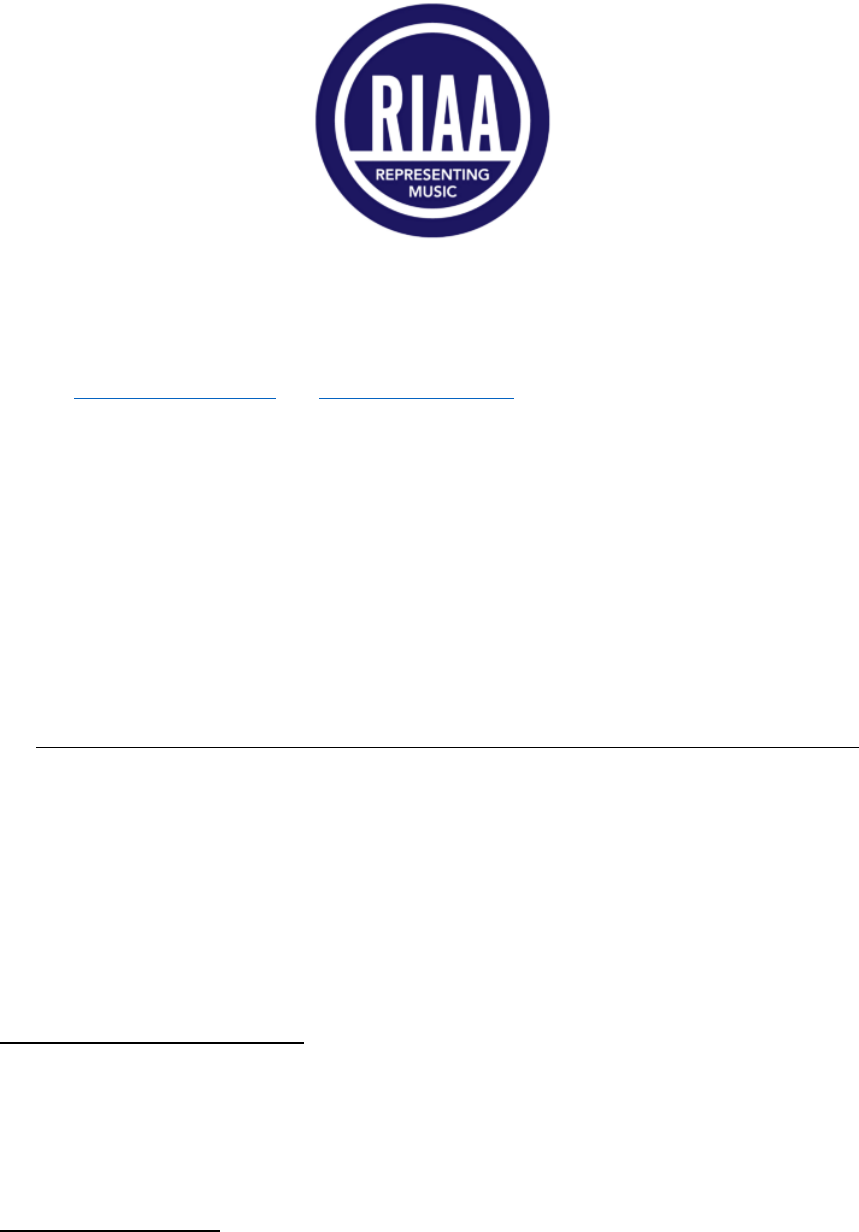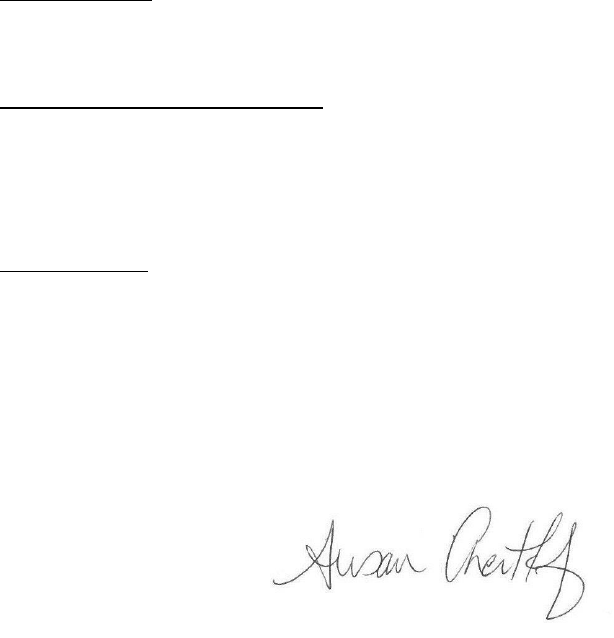
December 6, 2019
Via email at regans@copyright.gov and achau@copyright.gov
Regan A. Smith
General Counsel and Associate Register of Copyrights
Anna Chauvet
Assistant General Counsel
U.S. Copyright Office
Library of Congress
101 Independence Ave. SE
Washington, DC 20559-6000
RE: Summary of the December 4, 2019 Ex Parte Meeting regarding the Music Modernization Act
Implementing Regulations for the Blanket License for Digital Uses and Mechanical Licensing
Collective, Docket No. 2019-5___________________________________________________
Dear Ms. Smith and Ms. Chauvet,
On December 4, 2019, the following individuals from Universal Music Group (“UMG”) and the Recording
Industry Association of America, Inc. (“RIAA”) participated in a meeting with Regan Smith, Anna
Chauvet, Jason Sloan, John Riley, Holland Gormley and Cassandra Sciortino of the Copyright Office
concerning the above referenced matter: Amy Isbell and Kim Beauchamp of UMG; and Ken Doroshow,
Susan Chertkof and David Hughes of RIAA. The meeting focused exclusively on issues related to sound
recording data.
1. History of the Digital Supply Chain. Ms. Beauchamp described her background and experience in the
industry, her current position and responsibilities, the shift from paper-based to digital records and
the effort that went into developing the digital supply chain. She described how DMPs take a siloed
approach to record company catalogs, which avoids the need to dedupe their data. As a result,
when catalogs change hands record companies must manually remove the catalog from the old
company’s “account” and add it to the new company’s “account.”
2. Purpose of the Database. We reminded the Office that the MLC database is not meant to be an
authoritative sound recording database. The sound recording data is there solely to help identify
the musical work embedded in the sound recordings streamed by DMPs, so that the MLC can pay

Ms. Regan Smith and Ms. Anna Chauvet
December 6, 2019
Page 2
the relevant writers and publishers. For this reason and because of the various concerns about the
sound recording data discussed at the meeting, we highlighted the need for a strong disclaimer.
3. Data Quality. We discussed a number of marketplace realities that affect the quality of the sound
recording data that is available to the MLC.
a. Data is most accurate when it is obtained as close to the source as possible. We discussed
the new RIN (i.e., Recording Information Notification) message from DDEX, which captures
data in the studio and is the ultimate tool for capturing data at the source. We discussed the
fact that the quality of data can vary among different genres of music, and that artists or
performers sometimes do not want their names to appear in credits or to be listed in a
publicly available database (e.g., when an established artist sits in to help a newer artist).
b. We reiterated the suggestion in our Initial Comments that the MLC be required to obtain its
sound recording data from a single authoritative source, such as SoundExchange.
c. We explained that SoundExchange gets the same data feeds as the DMPs (for purposes of
distributing statutory licensing royalties) but then it dedupes and deconflicts the data.
SoundExchange receives data from approximately 3400 labels, including certain
independent distributors (e.g., CdBaby). If the MLC does not get its data from a single
authoritative source, such as SoundExchange, it will be faced with the burden of reconciling
data conflicts that have been ignored for years because of the way the DMPs silo their label
data. SoundExchange has already reconciled most of those conflicts.
d. We gave examples of how and why the DMPs alter and augment the metadata they receive
from the labels and noted that any data provided by the DMPs to the MLC must be
submitted in unaltered form.
e. We stressed that the database should not be populated from usage reports because those
are subject to typographical and other human errors; instead, it should be populated from a
single authoritative source. Once the database is populated, DMPs should ping the database
to derive the information needed to populate their reports of use. Where a track is not
already in the MLC database, the DMP should include it in its report of use but when that
data appears in the database it should be flagged as unverified or from a non-authoritative
source.
4. Sound Recording Copyright Owner Data. We explained the difference between the data in the digital
supply chain, where actual copyright ownership is irrelevant, and the record companies’ copyright
registration and royalty databases, which the record companies use for litigation purposes and to
know who to pay for various recordings. DMPs only need to know who to pay and, maybe, who to
call if issues arise. We discussed how data labelling the supply chain data as “sound recording
copyright owner” could mislead the public and could be upsetting to the actual copyright owners,
who are sometimes artists or their heirs, who may mistakenly think the distributing label is trying to
claim ownership of their recordings. Conversely, artists who are the actual copyright owners likely
do not want their names listed in a publicly accessible database. We noted that the
SoundExchange’s ISRC look up database does not include owner information and it is not currently
available for bulk download by the public. We also highlighted that making ISRCs publicly available in
bulk could also raise piracy concerns.

Ms. Regan Smith and Ms. Anna Chauvet
December 6, 2019
Page 3
We discussed different deal structures between record companies and artists/smaller labels
including “P&D” deals, where the record company is merely a conduit to the digital supply chain,
and exclusive licensing deals, where the record company stands in the shoes of the owner. We
explained that many smaller labels don’t have their own digital supply chain so they use a bigger
label to digitally distribute their product. Those distributed labels often change distributors after
their catalog is in the digital supply chain, making some of the metadata wrong until it is updated.
We mentioned other potentially relevant fields in the ERN message such as imprint label and party
ID. The Copyright Office team asked us to send them a copy of the ERN specification, which we
intend to do. They also asked whether there are any other fields in the specification that are
typically populated in a way that would not be obvious to the uninformed. We talked about possibly
of renaming the field or naming the field in the alternative (e.g., “sound recording copyright owner
or its designee” or “sound recording administrator”). The Office asked whether it might be better to
populate the sound recording copyright owner field with the p-line data in an ERN message and we
pointed out that there is no p-line for pre-72 recordings.
5. Unique Identifier. We discussed the importance of all reports of use including a unique numerical
identifier, i.e., ISRC, to help distinguish situations where, for example, different artists record
different songs by the same name.
6. Value of Sound Recording Metadata. We discussed the large sums of money that UMG has invested
to create and maintain its digital supply chain data and the fact that UMG currently licenses that
data to third parties for substantial sums of money. If members of the public and third parties were
able to access the MLC database in bulk for a minimal fee, that would decimate the commercial
value of UMG’s metadata.
7. Public Education. We discussed the Office’s role under the statute in educating the public about the
new law and stressed the importance of educating young, up and coming musicians about the
importance of ISRCs and other numerical identifiers if they want to be paid in a digital economy.
Ms. Beauchamp offered to assist the Office in its efforts to educate the public.
We appreciated the ability to meet with the Copyright Office on these matters.
Sincerely,
Susan Chertkof
Senior Vice President, Legal and Regulatory Affairs
Recording Industry Association of America
